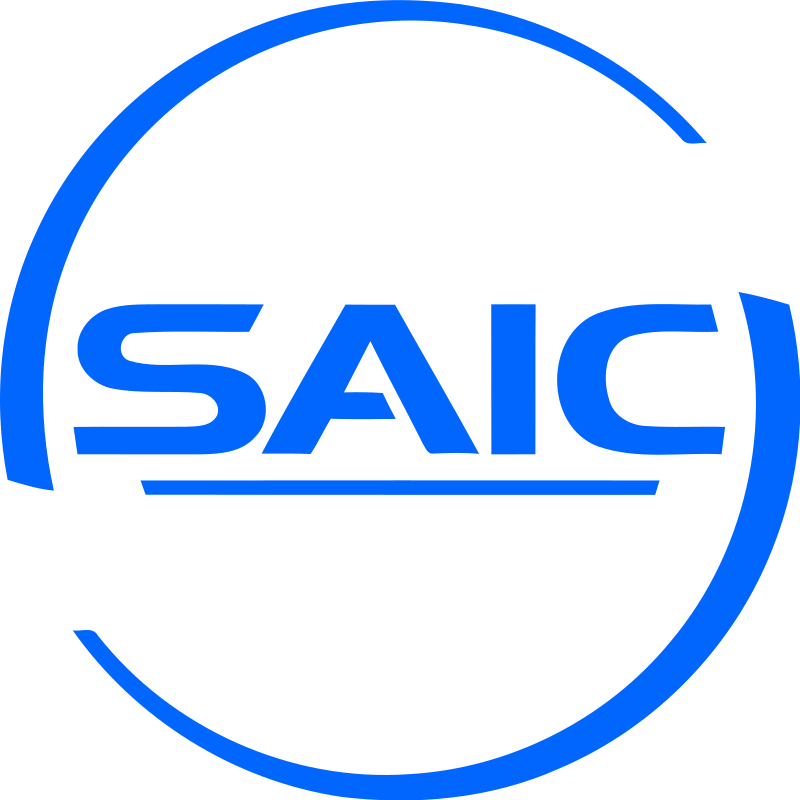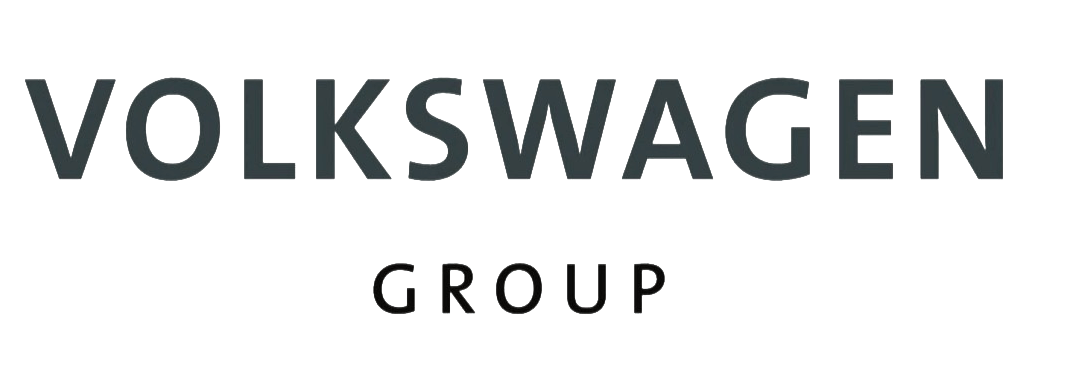Global In Car Payment Market By Payment Technology, By Application, By Region & Segmental Insights Trends and Forecast, 2024 – 2034
- Industry: Automotive & Transportation
- Report ID: TNR-110-1281
- Number of Pages: 420
- Table/Charts : Yes
- September, 2024
- Base Year : 2024
- No. of Companies : 10+
- No. of Countries : 29
- Views : 10053
- Covid Impact Covered: Yes
- War Impact Covered: Yes
- Formats : PDF, Excel, PPT
In Car Payment refers to a system that allows drivers and passengers to make payments directly from their vehicle without needing to use cash, credit cards, or mobile phones separately. This technology integrates payment options into the car’s infotainment system, allowing users to pay for services like fuel, parking, tolls, and even drive-thru food orders simply by interacting with the car’s dashboard or using voice commands. For example, when you pull up to a gas station, instead of getting out and swiping your card at the pump, you could select the fuel option on your car’s screen, choose your payment method, and the car will automatically pay for the gas. This can be done through various technologies like NFC (Near Field Communication), Bluetooth, or internet-based transactions. The global in car payment market accounted for US$ 6.50 Bn in 2023; anticipated to gain CAGR of 12.96% during 2024 – 2034.
The global in car payment market is expected to witness substantial growth over the next decade, driven by advancements in vehicle connectivity, the rise of electric vehicles (EVs), and the increasing demand for seamless, convenient payment experiences. The market’s expansion is also being bolstered by strategic collaborations between automotive manufacturers, financial institutions, and technology providers, which are collectively working to enhance the capabilities and security of in car payment systems.
Global In Car Payment Market Dynamics
Technological Advancements: One of the most critical factors driving the growth of the in car payment market is the rapid advancement of automotive technology. Modern vehicles are increasingly equipped with sophisticated infotainment systems that can integrate with various digital payment platforms. These systems leverage technologies such as near-field communication (NFC), Bluetooth, and mobile applications to enable secure and efficient payments. The rise of 5G connectivity further accelerates the adoption of in car payment solutions by ensuring faster and more reliable data transmission, which is essential for real-time payment processing.
The integration of voice-activated assistants, such as Amazon’s Alexa, Google’s Assistant, and Apple’s Siri, into vehicle infotainment systems is also a significant trend. These voice assistants allow drivers to make payments without taking their hands off the wheel, enhancing both convenience and safety. For instance, drivers can simply speak a command to pay for fuel or parking, streamlining the transaction process.
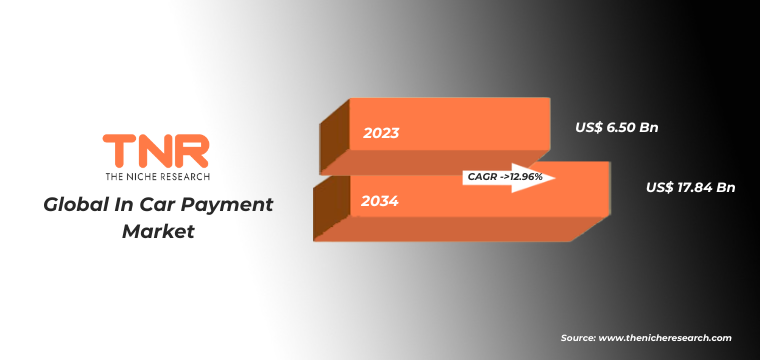
Adoption of Electric Vehicles (EVs)
The increasing adoption of electric vehicles (EVs) is another key driver for the in car payment market. EV owners require efficient payment solutions for charging their vehicles, whether at public charging stations or at home. The need for a seamless payment experience at charging stations has led to the development of in car payment systems that can automatically process payments as soon as the charging session is complete. This convenience is essential for EV drivers, who often seek out fast and hassle-free charging experiences.
Additionally, the growth of EVs is encouraging the establishment of smart charging networks that are integrated with in car payment systems. These networks allow for dynamic pricing, where the cost of charging can vary based on demand, location, and time of day. In-car payment systems can automatically adjust to these pricing models, providing a transparent and efficient payment process for EV owners.
Rise of Connected and Autonomous Vehicles
The proliferation of connected vehicles, which are equipped with internet connectivity and various sensors, is a significant growth factor for the in car payment market. These vehicles can communicate with external systems, such as payment gateways and service providers, to facilitate real-time transactions. Connected vehicles are also integral to the development of autonomous vehicles, which will further drive the demand for in car payment systems.
As autonomous vehicles become more prevalent, the need for hands-free payment solutions will increase. Autonomous vehicles will likely be used for ride-sharing services, where passengers will need to pay for their rides seamlessly. In-car payment systems will play a crucial role in enabling these transactions, allowing passengers to make payments without needing to interact with a driver or use a mobile device.
Increasing Consumer Demand for Convenience
Consumer preferences are increasingly shifting towards convenience and seamless experiences, both of which are core offerings of in car payment systems. As lifestyle has become more fast-paced, consumers are seeking ways to simplify routine tasks, such as paying for fuel, tolls, or parking. In-car payment systems provide a solution by allowing transactions to be completed within the vehicle, eliminating the need to carry cash or use physical payment cards.
Furthermore, the integration of loyalty programs and rewards into in car payment systems is enhancing their appeal. Consumers can earn points or receive discounts for making payments through these systems, incentivizing their use. For example, a driver might receive a discount on their next fuel purchase if they use the in car payment system at a partner gas station. Such incentives are likely to drive higher adoption rates among consumers.
Security Concerns and Challenges
Despite the numerous growth drivers, the in car payment market faces challenges related to security and privacy. As vehicles become more connected and integrated with payment systems, they also become potential targets for cyberattacks. Hackers could potentially exploit vulnerabilities in the vehicle’s software to gain access to sensitive financial information or disrupt payment transactions.
To mitigate these risks, companies are investing heavily in cybersecurity measures, such as encryption, multi-factor authentication, and regular software updates. Automotive manufacturers and payment service providers are working together to develop secure in car payment systems that can protect against potential threats.

Segmental Insights
In the in car payment market, Near Field Communication (NFC) and Telematics systems lead due to their widespread adoption and essential roles in facilitating seamless in-vehicle transactions. NFC technology, which supports quick and secure contactless payments, is particularly prevalent in modern vehicles. For instance, automakers like BMW and Mercedes-Benz have integrated NFC into their infotainment systems, enabling drivers to pay for services like parking and fuel directly from the car. In 2023, NFC technology accounted for over 30% of the in car payment market, reflecting the growing global trend toward contactless payment solutions. Similarly, Telematics systems, which connect vehicles to external networks for real-time data exchange, are crucial for processing payments for services like tolls and fuel, making them a dominant force in this evolving market.
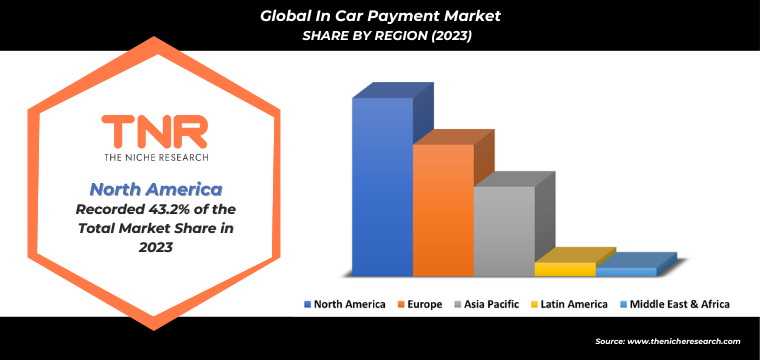
Regional Insights
The adoption of in car payment systems varies across regions, driven by differences in technology adoption, consumer behaviour, and regulatory environments.
- North America: The North American in car payment market accounted for approximately 43.2% market share. This dominant position is attributed to the widespread adoption of connected vehicles and the significant presence of major automotive and technology companies in the region. The region’s consumers are also highly receptive to new technologies, contributing to faster adoption rates.
- Europe: Europe is another significant market for in car payments, particularly in countries with a strong focus on sustainability and electric vehicles. The European Union’s stringent data protection regulations also influence the development of secure in car payment systems in the region.
- Asia-Pacific: The Asia-Pacific region is expected to experience rapid growth of over 14% in the in car payment market, driven by the rising adoption of connected vehicles in countries like China, Japan, and South Korea. The region’s growing middle class and increasing urbanization are also contributing to the demand for convenient payment solutions.
Global In Car Payment Market Participants
- Amazon
- Google Pay
- Hyundai
- Jaguar
- MasterCard
- PayPal
- Shell
- Visa
- Other Market Participants
Global In Car Payment Market
| Report Specifications | Details |
| Market Revenue in 2023 | US$ 6.50 Bn |
| Market Size Forecast by 2034 | US$ 17.84 Bn |
| Growth Rate (CAGR) | 12.96% |
| Historic Data | 2018 – 2022 |
| Base Year for Estimation | 2023 |
| Forecast Period | 2024 – 2034 |
| Report Inclusions | Market Size & Estimates, Market Dynamics, Competitive Scenario, Trends, Growth Factors, Market Determinants, Key Investment Segmentation, Product/Service/Solutions Benchmarking |
| Segments Covered | By Payment Technology, By Application |
| Regions Covered | North America, Europe, Asia Pacific, Middle East & Africa, Latin America |
| Countries Covered | U.S., Canada, Mexico, Rest of North America, France, The UK, Spain, Germany, Italy, Nordic Countries (Denmark, Finland, Iceland, Sweden, Norway), Benelux Union (Belgium, The Netherlands, Luxembourg), Rest of Europe, China, Japan, India, New Zealand, Australia, South Korea, Southeast Asia (Indonesia, Thailand, Malaysia, Singapore, Rest of Southeast Asia), Rest of Asia Pacific, Saudi Arabia, UAE, Egypt, Kuwait, South Africa, Rest of Middle East & Africa, Brazil, Argentina, Rest of Latin America |
| Key Players | Google Pay, Amazon, Visa, MasterCard, PayPal, Shell, Jaguar, Hyundai, Other Market Participants |
| Customization Scope | Customization allows for the inclusion/modification of content pertaining to geographical regions, countries, and specific market segments. |
| Pricing & Procurement Options | Explore purchase options tailored to your specific research requirements |
| Contact Details | Consult With Our Expert
Japan (Toll-Free): +81 663-386-8111 South Korea (Toll-Free): +82-808- 703-126 Saudi Arabia (Toll-Free): +966 800-850-1643 United Kingdom: +44 753-710-5080 United States: +1 302-232-5106 E-mail: askanexpert@thenicheresearch.com |
Global In Car Payment Market
By Payment Technology
- Internet of Things (IoT)
- Telematics systems
- Near Field Communication (NFC)
- Biometric authentication
- Cloud Token Frameworks
- Others
By Application
- Pay-at-the-Pump (Fuel) Payment
- Smart Parking Payment
- Toll Payment
- Car Rental Payment
- Automated Repair Payments
- Drive-Thru Purchases
- Others
By Region
- North America (U.S., Canada, Mexico, Rest of North America)
- Europe (France, The UK, Spain, Germany, Italy, Nordic Countries (Denmark, Finland, Iceland, Sweden, Norway), Benelux Union (Belgium, The Netherlands, Luxembourg), Rest of Europe)
- Asia Pacific (China, Japan, India, New Zealand, Australia, South Korea, Southeast Asia (Indonesia, Thailand, Malaysia, Singapore, Rest of Southeast Asia), Rest of Asia Pacific)
- Middle East & Africa (Saudi Arabia, UAE, Egypt, Kuwait, South Africa, Rest of Middle East & Africa)
- Latin America (Brazil, Argentina, Rest of Latin America)
Global In Car Payment Market
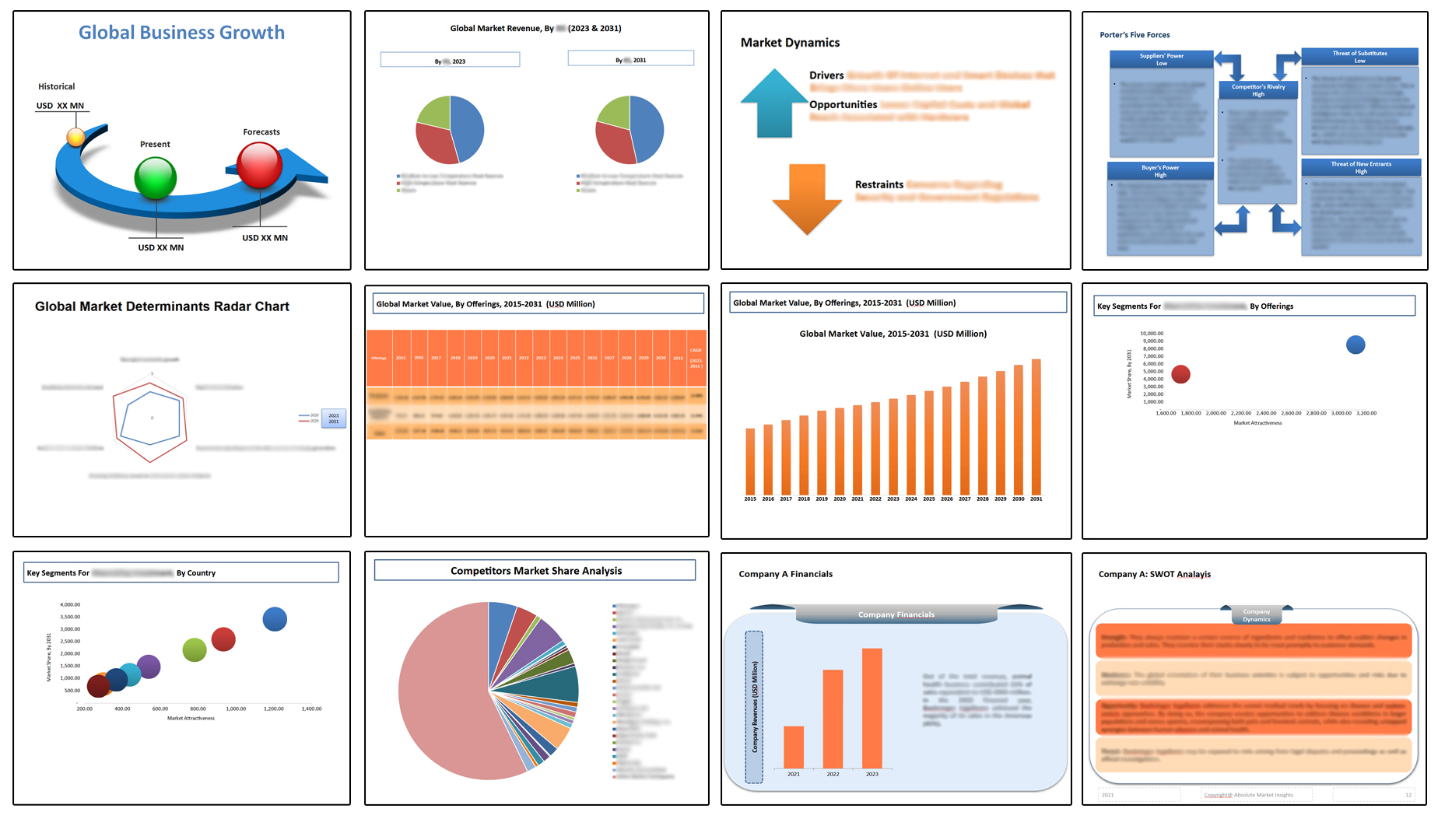
Table of Contents
**Exclusive for Multi-User and Enterprise User.
Global In Car Payment Market:
By Payment Technology
- Internet of Things (IoT)
- Telematics systems
- Near Field Communication (NFC)
- Biometric authentication
- Cloud Token Frameworks
- Others
By Application
- Pay-at-the-Pump (Fuel) Payment
- Smart Parking Payment
- Toll Payment
- Car Rental Payment
- Automated Repair Payments
- Drive-Thru Purchases
- Others
By Region
- North America (U.S., Canada, Mexico, Rest of North America)
- Europe (France, The UK, Spain, Germany, Italy, Nordic Countries (Denmark, Finland, Iceland, Sweden, Norway), Benelux Union (Belgium, The Netherlands, Luxembourg), Rest of Europe)
- Asia Pacific (China, Japan, India, New Zealand, Australia, South Korea, Southeast Asia (Indonesia, Thailand, Malaysia, Singapore, Rest of Southeast Asia), Rest of Asia Pacific)
- Middle East & Africa (Saudi Arabia, UAE, Egypt, Kuwait, South Africa, Rest of Middle East & Africa)
- Latin America (Brazil, Argentina, Rest of Latin America)
The Niche Research approach encompasses both primary and secondary research methods to provide comprehensive insights. While primary research is the cornerstone of our studies, we also incorporate secondary research sources such as company annual reports, premium industry databases, press releases, industry journals, and white papers.
Within our primary research, we actively engage with various industry stakeholders, conducting paid interviews and surveys. Our meticulous analysis extends to every market participant in major countries, allowing us to thoroughly examine their portfolios, calculate market shares, and segment revenues.
Our data collection primarily focuses on individual countries within our research scope, enabling us to estimate regional market sizes. Typically, we employ a bottom-up approach, meticulously tracking trends in different countries. We analyze growth drivers, constraints, technological innovations, and opportunities for each country, ultimately arriving at regional figures.Our process begins by examining the growth prospects of each country. Building upon these insights, we project growth and trends for the entire region. Finally, we utilize our proprietary model to refine estimations and forecasts.
Our data validation standards are integral to ensuring the reliability and accuracy of our research findings. Here’s a breakdown of our data validation processes and the stakeholders we engage with during our primary research:
- Supply Side Analysis: We initiate a supply side analysis by directly contacting market participants, through telephonic interviews and questionnaires containing both open-ended and close-ended questions. We gather information on their portfolios, segment revenues, developments, and growth strategies.
- Demand Side Analysis: To gain insights into adoption trends and consumer preferences, we reach out to target customers and users (non-vendors). This information forms a vital part of the qualitative analysis section of our reports, covering market dynamics, adoption trends, consumer behavior, spending patterns, and other related aspects.
- Consultant Insights: We tap into the expertise of our partner consultants from around the world to obtain their unique viewpoints and perspectives. Their insights contribute to a well-rounded understanding of the markets under investigation.
- In-House Validation: To ensure data accuracy and reliability, we conduct cross-validation of data points and information through our in-house team of consultants and utilize advanced data modeling tools for thorough verification.
The forecasts we provide are based on a comprehensive assessment of various factors, including:
- Market Trends and Past Performance (Last Five Years): We accurately analyze market trends and performance data from preceding five years to identify historical patterns and understand the market’s evolution.
- Historical Performance and Growth of Market Participants: We assess the historical performance and growth trajectories of key market participants. This analysis provides insights into the competitive landscape and individual company strategies.
- Market Determinants Impact Analysis (Next Eight Years): We conduct a rigorous analysis of the factors that are projected to influence the market over the next eight years. This includes assessing both internal and external determinants that can shape market dynamics.
- Drivers and Challenges for the Forecast Period:Identify the factors expected to drive market growth during the forecast period, as well as the challenges that the industry may face. This analysis aids in deriving an accurate growth rate projection.
- New Acquisitions, Collaborations, or Partnerships: We keep a close watch on any new acquisitions, collaborations, or partnerships within the industry. These developments can have a significant impact on market dynamics and competitiveness.
- Macro and Micro Factors Analysis:A thorough examination of both macro-level factors (e.g., economic trends, regulatory changes) and micro-level factors (e.g., technological advancements, consumer preferences) that may influence the market during the forecast period.
- End-User Sentiment Analysis: To understand the market from the end-user perspective, we conduct sentiment analysis. This involves assessing the sentiment, preferences, and feedback of the end-users, which can provide valuable insights into market trends.
- Perspective of Primary Participants: Insights gathered directly from primary research participants play a crucial role in shaping our forecasts. Their perspectives and experiences provide valuable qualitative data.
- Year-on-Year Growth Trend: We utilize a year-on-year growth trend based on historical market growth and expected future trends. This helps in formulating our growth projections, aligning them with the market’s historical performance.
Research process adopted by TNR involves multiple stages, including data collection, validation, quality checks, and presentation. It’s crucial that the data and information we provide add value to your existing market understanding and expertise. We have also established partnerships with business consulting, research, and survey organizations across regions and globally to collaborate on regional analysis and data validation, ensuring the highest level of accuracy and reliability in our reports.


